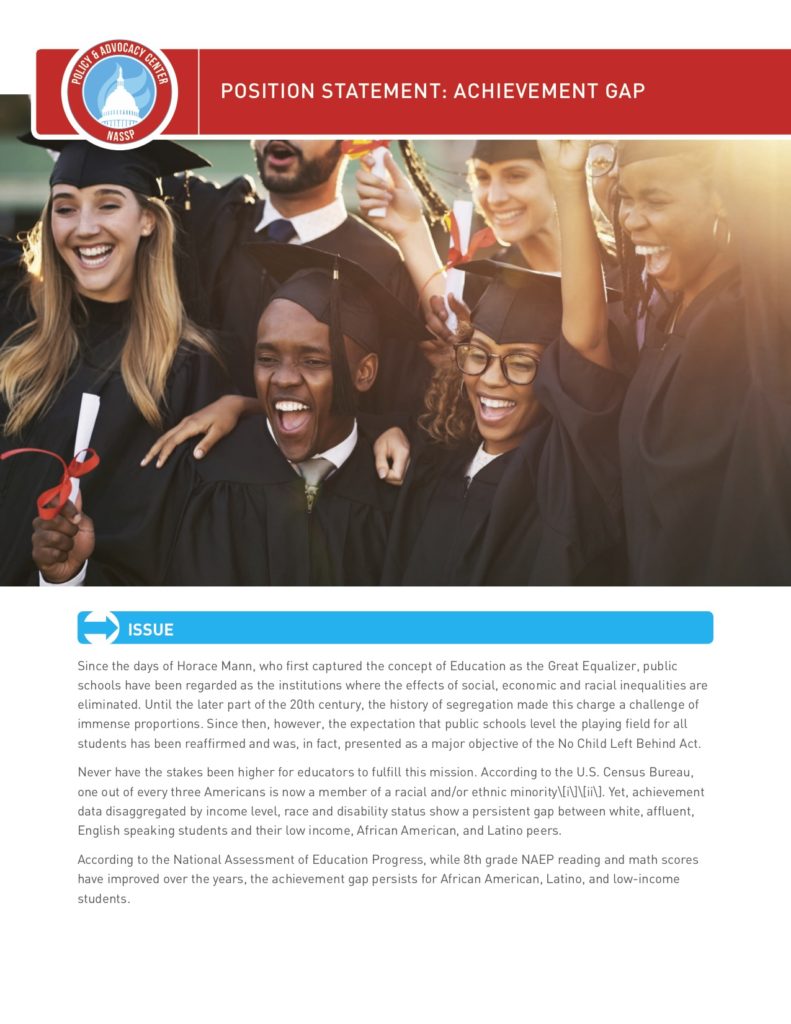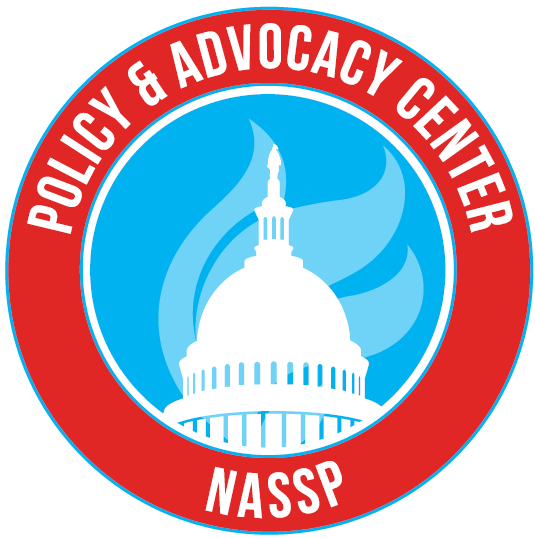Since the days of Horace Mann, who first captured the concept of Education as the Great Equalizer, public schools have been regarded as the institutions where the effects of social, economic and racial inequalities are eliminated. Until the later part of the 20th century, the history of segregation made this charge a challenge of immense proportions. Since then, however, the expectation that public schools level the playing field for all students has been reaffirmed and was, in fact, presented as a major objective of the No Child Left Behind Act.
Never have the stakes been higher for educators to fulfill this mission. According to the U.S. Census Bureau, one out of every three Americans is now a member of a racial and/or ethnic minority\[i\]\[ii\]. Yet, achievement data disaggregated by income level, race and disability status show a persistent gap between white, affluent, English speaking students and their low income, African American, and Latino peers.
According to the National Assessment of Education Progress, while 8th grade NAEP reading and math scores have improved over the years, the achievement gap persists for African American, Latino, and low-income students.
According to the National Center for Education Statistics, since the early 1990s, the achievement gaps in reading and mathematics between White and Black and White and Hispanic 4th- and 8th-graders have shown little measurable change\[iii\].
The high school dropout rate for African American and Latino students continues to be unacceptably high. According to the 2007 National Center for Education Statistics, 10.4 percent of African American students and 22.4 percent of Hispanic students dropped out of high school in 2005\[iv\]. Other studies report that urban districts with predominantly minority student populations have dropout rates near 50 percent\[v\].
Two schools of thought have dominated the conversation around the achievement gap. One, promoted by a number of education reformers, advocates, and the business community, contend that schools do have the capacity to close the achievement gap, but don’t have the will to do so. Arguing that a number of schools do, against all odds, successfully narrow the achievement gap for their students, these groups suggest replicating practices implemented in these outstanding schools. The achievement gap, according to this thesis, is simply an expectation gap. Solutions proposed include holding schools accountable for narrowing or closing the achievement gap, higher expectations, academic rigor for all, and highly qualified educators.
On the other end of the spectrum, some argue that schools simply don’t have the capacity to close the gap because they only reflect inequities in the larger society. They argue that although schools receive much of the blame, the gap is more the result of social class characteristics that are beyond the control of even the best schools and teachers. This thesis dramatically diminishes the impact schools can have in closing the achievement gap. Solutions proposed include social interventions aimed at combating the effect of poverty, such as better housing and healthcare, that impact children’s capacity to succeed in schools.
Guiding Principles
- Although factors external to schools are paramount in creating the achievement gap, NASSP believes that schools have a responsibility to address this challenge. It should be unmistakably clear that only a truly collective effort (educators, parents, community leaders and policymakers) will ensure that children of poverty and other disadvantaged backgrounds have an equal opportunity to succeed in school.
- NASSP believes that the various government entities and societal institutions have a responsibility to address the myriad and complex conditions impacting students’ capacity to learn, such as poverty, housing, health care, unemployment and nutrition.
- NASSP and other groups have identified schools and districts that have successfully narrowed the gap.\[vi\] These schools hold a piece of the solution and provide examples of best practices that other schools can emulate.
- NASSP believes, and recent research has confirmed, that school leadership affects student achievement (second only to instruction, particularly for at-risk students). Principals and assistant principals play a critical role in leading schools’ efforts to narrow the achievement gap.
- NASSP offers Breaking Ranks II™ and Breaking Ranks in the Middle™ as tools that provide school leaders with a framework for raising awareness of the achievement gap and strategies to address it.
Recommendations
The achievement gap is the product of a multitude of factors all working together. Consequently, the solution to this problem must be no less multifaceted, no less complex and comprehensive.
NASSP calls on school leaders to:
- Align all programs and structures in their schools so that all social, economic, and racial/ethnic groups have open and equal access to challenging activities and learning\[vii\]
- Construct teams with a range of expertise levels to encourage peer mentoring and ensure that a particular group of students does not get the uncertified, unqualified or unprepared teachers
- Review the composition of the student body. Document that minorities are proportionately represented in challenging classes and not disproportionately represented in less challenging classes or special education classes
- Implement academic and social support mechanisms to help low performing students
- Place their most qualified teachers to teach those in greatest need, so that these students do not fall farther and farther behind
- Ensure that each student has a personal plan for progress that the student, family, and adviser/teacher/counselor review regularly
- Encourage transitions and alignment from grade to grade and across disciplines
- Develop students’ ability to participate in and lead conversations focused on making diversity a valued part of the learning experience
- Engage teachers in ongoing professional development that addresses assumptions and stereotypes and becomes part of the school improvement plan
- Partner with community organizations to provide vulnerable students academic and social support services
- Provide at risk students with awareness and opportunities for post-secondary education.
NASSP calls on policymakers to:
- Expand health coverage to children and families living in poverty
- Establish policies that eliminate children’s health disparities
- Increase earned income tax credits for low wages to help offset the unequal distribution of incomes
- Fund in-school academic and social support mechanisms that help low performing students
- Fund after school and summer activities for children in low income families
- Support school principals in their efforts to place the most qualified teachers with the most vulnerable students
- Provide incentives for the most effective teachers to teach in the hardest to staff schools
- Provide funding for Headstart programs
- Provide pre-K education for the most at-risk students
- Provide opportunities for post-secondary education
- Increase access of low income families to stable (permanent) housing.
Resources
U.S. Census Bureau, May 17, 2007. https://www.census.gov/library/publications.html/
National Center for Education Statistics: Trends in the Achievement Gaps in Reading and Mathematics, 2006. https://nces.ed.gov/nationsreportcard/pubs/studies/2009455.aspx
IES National Center for Education Statistics, 2007. Indicator 23.
Balfanz, R. &Letgers, N., 2004. Locating the Dropout Crisis. http://web.jhu.edu/CSOS/graduation-gap/power/report70.pdf


